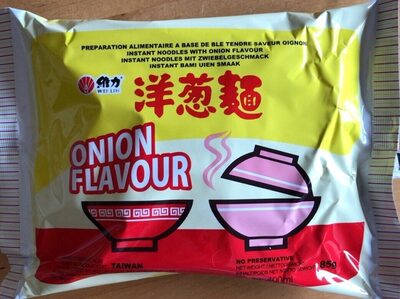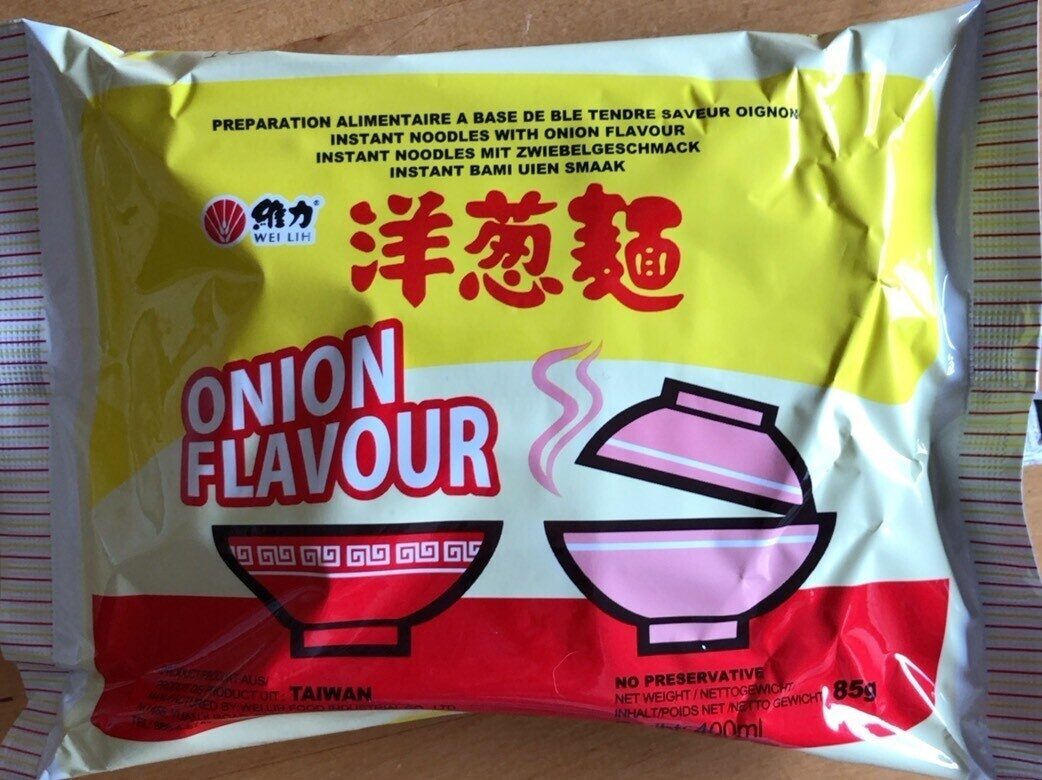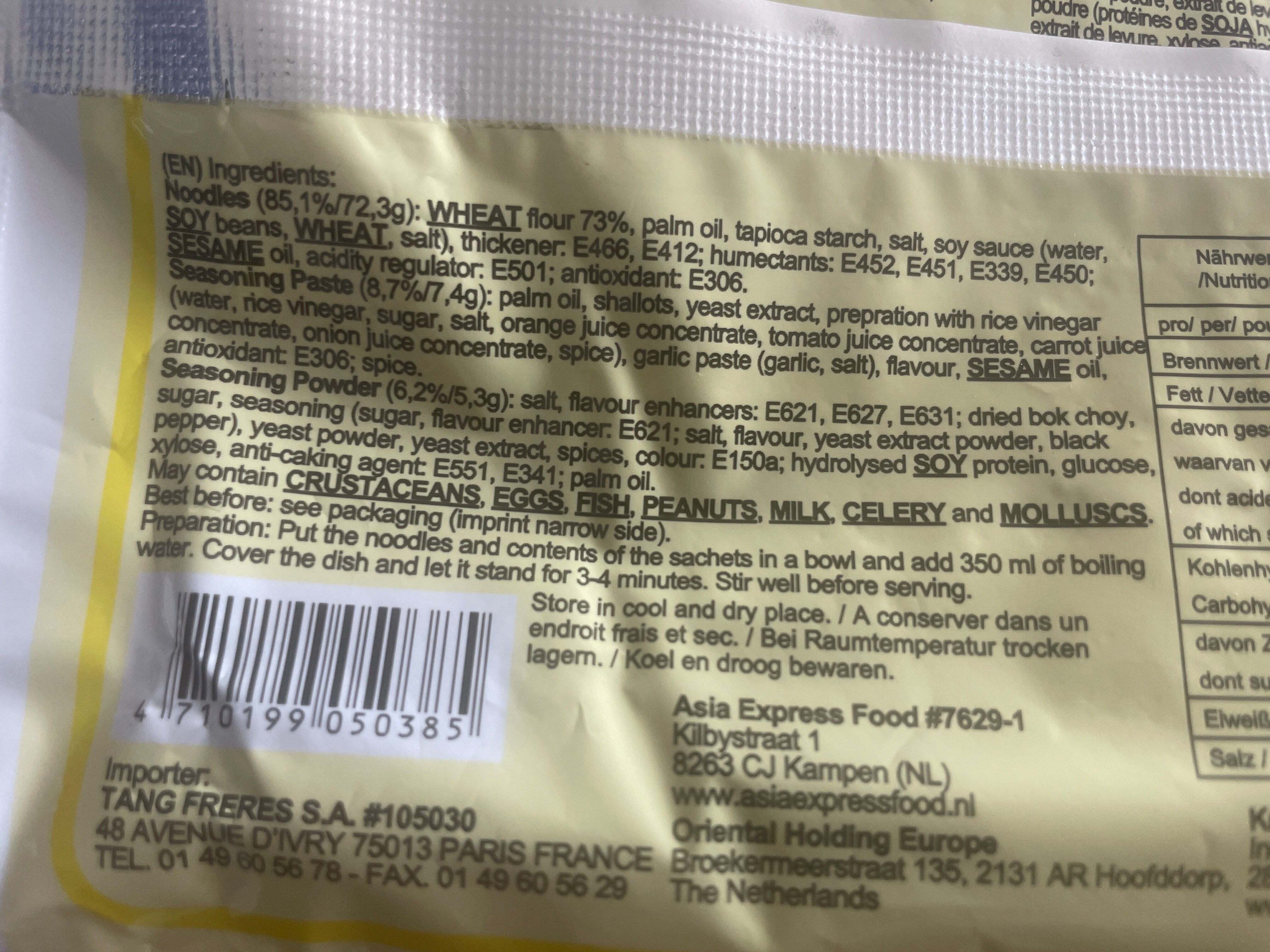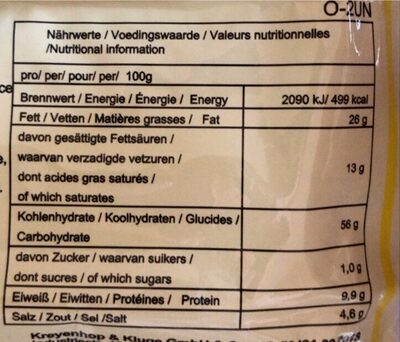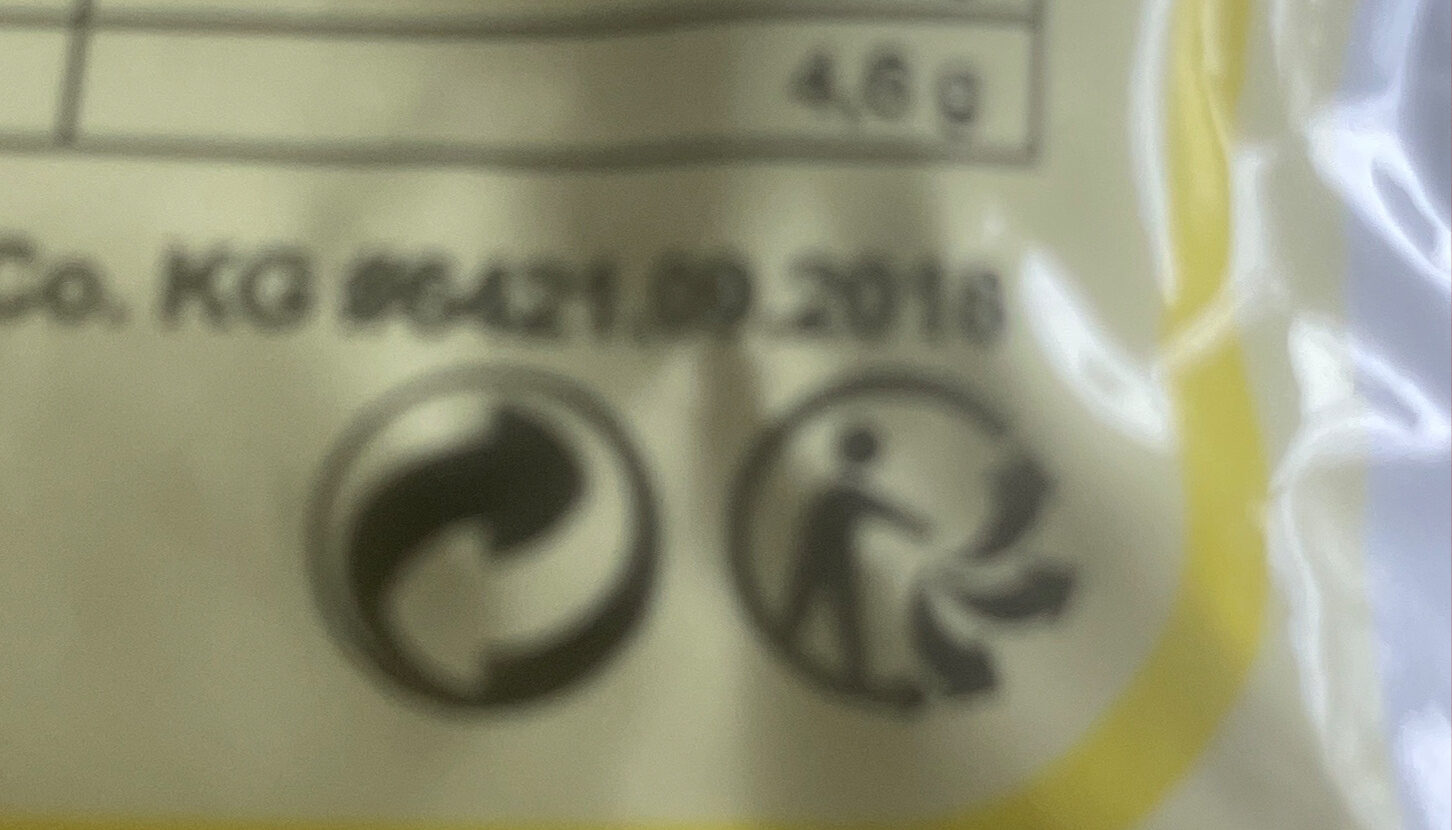Help us make food transparency the norm!
As a non-profit organization, we depend on your donations to continue informing consumers around the world about what they eat.
The food revolution starts with you!
Préparation alimentaire à base de blé tendre saveur oignon - Wei Lih - 85g
Préparation alimentaire à base de blé tendre saveur oignon - Wei Lih - 85g
This product page is not complete. You can help to complete it by editing it and adding more data from the photos we have, or by taking more photos using the app for Android or iPhone/iPad. Thank you!
×
Barcode: 4710199050385 (EAN / EAN-13)
Quantity: 85g
Packaging: Bag
Brands: Wei Lih
Categories: Plant-based foods and beverages, Plant-based foods, Cereals and potatoes, Cereals and their products, Meals, Dried products, Pastas, Dried products to be rehydrated, Noodles, Soups, Instant noodles, Instant noodle soups
Manufacturing or processing places: Taiwan
Stores: Paris Store
Countries where sold: France
Matching with your preferences
Health
Ingredients
-
62 ingredients
noodles (84.2%): soft wheat flour 70%, palm oil, tapioca starch, salt, soy sauce (soy, wheat, water, salt), thickeners (e466, e412), sesame oil, acidity corrector (e501), humectants (e452, e451, e339, e450), antioxidant (e306), dye (e160a), seasoning paste (10%): refined palm oil, onion 19.6%, garlic paste, sesame oil, antioxidant (e306), cinnamon powder , seasoning powder (5.8%): salt, flavor enhancer (e621), dehydrated chinese cabbage, spices (black pepper, powdered pepper, powdered anise), flavor enhancers (e631, e627), powdered yeast, black vinegar powder (dextrin, sugar, acidity corrector (e262, e260), pepper, cinnamon, cardamom, cloves, common wheat), dye (e150a), anti-caking agent (e341), yeast extractAllergens: Gluten, Soybeans
Food processing
-
Ultra processed foods
Elements that indicate the product is in the 4 - Ultra processed food and drink products group:
- Additive: E1400 - Dextrin
- Additive: E150a - Plain caramel
- Additive: E160a - Carotene
- Additive: E412 - Guar gum
- Additive: E450 - Diphosphates
- Additive: E451 - Triphosphates
- Additive: E452 - Polyphosphates
- Additive: E466 - Sodium carboxy methyl cellulose
- Additive: E621 - Monosodium glutamate
- Additive: E627 - Disodium guanylate
- Additive: E631 - Disodium inosinate
- Ingredient: Colour
- Ingredient: Flavour enhancer
- Ingredient: Humectant
- Ingredient: Thickener
Food products are classified into 4 groups according to their degree of processing:
- Unprocessed or minimally processed foods
- Processed culinary ingredients
- Processed foods
- Ultra processed foods
The determination of the group is based on the category of the product and on the ingredients it contains.
Additives
-
E1400 - Dextrin
Dextrin: Dextrins are a group of low-molecular-weight carbohydrates produced by the hydrolysis of starch or glycogen. Dextrins are mixtures of polymers of D-glucose units linked by α--1→4- or α--1→6- glycosidic bonds. Dextrins can be produced from starch using enzymes like amylases, as during digestion in the human body and during malting and mashing, or by applying dry heat under acidic conditions -pyrolysis or roasting-. The latter process is used industrially, and also occurs on the surface of bread during the baking process, contributing to flavor, color and crispness. Dextrins produced by heat are also known as pyrodextrins. The starch hydrolyses during roasting under acidic conditions, and short-chained starch parts partially rebranch with α--1‚6- bonds to the degraded starch molecule. See also Maillard Reaction. Dextrins are white, yellow, or brown powders that are partially or fully water-soluble, yielding optically active solutions of low viscosity. Most of them can be detected with iodine solution, giving a red coloration; one distinguishes erythrodextrin -dextrin that colours red- and achrodextrin -giving no colour-. White and yellow dextrins from starch roasted with little or no acid are called British gum.Source: Wikipedia
-
E160a - Carotene
Carotene: The term carotene -also carotin, from the Latin carota, "carrot"- is used for many related unsaturated hydrocarbon substances having the formula C40Hx, which are synthesized by plants but in general cannot be made by animals -with the exception of some aphids and spider mites which acquired the synthesizing genes from fungi-. Carotenes are photosynthetic pigments important for photosynthesis. Carotenes contain no oxygen atoms. They absorb ultraviolet, violet, and blue light and scatter orange or red light, and -in low concentrations- yellow light. Carotenes are responsible for the orange colour of the carrot, for which this class of chemicals is named, and for the colours of many other fruits, vegetables and fungi -for example, sweet potatoes, chanterelle and orange cantaloupe melon-. Carotenes are also responsible for the orange -but not all of the yellow- colours in dry foliage. They also -in lower concentrations- impart the yellow coloration to milk-fat and butter. Omnivorous animal species which are relatively poor converters of coloured dietary carotenoids to colourless retinoids have yellowed-coloured body fat, as a result of the carotenoid retention from the vegetable portion of their diet. The typical yellow-coloured fat of humans and chickens is a result of fat storage of carotenes from their diets. Carotenes contribute to photosynthesis by transmitting the light energy they absorb to chlorophyll. They also protect plant tissues by helping to absorb the energy from singlet oxygen, an excited form of the oxygen molecule O2 which is formed during photosynthesis. β-Carotene is composed of two retinyl groups, and is broken down in the mucosa of the human small intestine by β-carotene 15‚15'-monooxygenase to retinal, a form of vitamin A. β-Carotene can be stored in the liver and body fat and converted to retinal as needed, thus making it a form of vitamin A for humans and some other mammals. The carotenes α-carotene and γ-carotene, due to their single retinyl group -β-ionone ring-, also have some vitamin A activity -though less than β-carotene-, as does the xanthophyll carotenoid β-cryptoxanthin. All other carotenoids, including lycopene, have no beta-ring and thus no vitamin A activity -although they may have antioxidant activity and thus biological activity in other ways-. Animal species differ greatly in their ability to convert retinyl -beta-ionone- containing carotenoids to retinals. Carnivores in general are poor converters of dietary ionone-containing carotenoids. Pure carnivores such as ferrets lack β-carotene 15‚15'-monooxygenase and cannot convert any carotenoids to retinals at all -resulting in carotenes not being a form of vitamin A for this species-; while cats can convert a trace of β-carotene to retinol, although the amount is totally insufficient for meeting their daily retinol needs.Source: Wikipedia
-
E260 - Acetic acid
Acetic acid: Acetic acid , systematically named ethanoic acid , is a colorless liquid organic compound with the chemical formula CH3COOH -also written as CH3CO2H or C2H4O2-. When undiluted, it is sometimes called glacial acetic acid. Vinegar is no less than 4% acetic acid by volume, making acetic acid the main component of vinegar apart from water. Acetic acid has a distinctive sour taste and pungent smell. In addition to household vinegar, it is mainly produced as a precursor to polyvinyl acetate and cellulose acetate. It is classified as a weak acid since it only partially dissociates in solution, but concentrated acetic acid is corrosive and can attack the skin. Acetic acid is the second simplest carboxylic acid -after formic acid-. It consists of a methyl group attached to a carboxyl group. It is an important chemical reagent and industrial chemical, used primarily in the production of cellulose acetate for photographic film, polyvinyl acetate for wood glue, and synthetic fibres and fabrics. In households, diluted acetic acid is often used in descaling agents. In the food industry, acetic acid is controlled by the food additive code E260 as an acidity regulator and as a condiment. In biochemistry, the acetyl group, derived from acetic acid, is fundamental to all forms of life. When bound to coenzyme A, it is central to the metabolism of carbohydrates and fats. The global demand for acetic acid is about 6.5 million metric tons per year -Mt/a-, of which approximately 1.5 Mt/a is met by recycling; the remainder is manufactured from methanol. Vinegar is mostly dilute acetic acid, often produced by fermentation and subsequent oxidation of ethanol.Source: Wikipedia
-
E262 - Sodium acetates
Sodium acetate: Sodium acetate, CH3COONa, also abbreviated NaOAc, is the sodium salt of acetic acid. This colorless deliquescent salt has a wide range of uses.Source: Wikipedia
-
E339 - Sodium phosphates
Sodium phosphates: Sodium phosphate is a generic term for a variety of salts of sodium -Na+- and phosphate -PO43−-. Phosphate also forms families or condensed anions including di-, tri-, tetra-, and polyphosphates. Most of these salts are known in both anhydrous -water-free- and hydrated forms. The hydrates are more common than the anhydrous forms.Source: Wikipedia
-
E341 - Calcium phosphates
Calcium phosphate: Calcium phosphate is a family of materials and minerals containing calcium ions -Ca2+- together with inorganic phosphate anions. Some so-called calcium phosphates contain oxide and hydroxide as well. They are white solids of nutritious value.Source: Wikipedia
-
E412 - Guar gum
Guar gum (E412) is a natural food additive derived from guar beans.
This white, odorless powder is valued for its remarkable thickening and stabilizing properties, making it a common ingredient in various food products, including sauces, dressings, and ice creams.
When used in moderation, guar gum is considered safe for consumption, with no known adverse health effects.
-
E450 - Diphosphates
Diphosphates (E450) are food additives often utilized to modify the texture of products, acting as leavening agents in baking and preventing the coagulation of canned food.
These salts can stabilize whipped cream and are also found in powdered products to maintain their flow properties. They are commonly present in baked goods, processed meats, and soft drinks.
Derived from phosphoric acid, they're part of our daily phosphate intake, which often surpasses recommended levels due to the prevalence of phosphates in processed foods and drinks.
Excessive phosphate consumption is linked to health issues, such as impaired kidney function and weakened bone health. Though diphosphates are generally regarded as safe when consumed within established acceptable daily intakes, it's imperative to monitor overall phosphate consumption to maintain optimal health.
-
E451 - Triphosphates
Sodium triphosphate: Sodium triphosphate -STP-, also sodium tripolyphosphate -STPP-, or tripolyphosphate -TPP-,- is an inorganic compound with formula Na5P3O10. It is the sodium salt of the polyphosphate penta-anion, which is the conjugate base of triphosphoric acid. It is produced on a large scale as a component of many domestic and industrial products, especially detergents. Environmental problems associated with eutrophication are attributed to its widespread use.Source: Wikipedia
-
E466 - Sodium carboxy methyl cellulose
Carboxymethyl cellulose: Carboxymethyl cellulose -CMC- or cellulose gum or tylose powder is a cellulose derivative with carboxymethyl groups --CH2-COOH- bound to some of the hydroxyl groups of the glucopyranose monomers that make up the cellulose backbone. It is often used as its sodium salt, sodium carboxymethyl cellulose.Source: Wikipedia
-
E501 - Potassium carbonates
Potassium carbonate: Potassium carbonate -K2CO3- is a white salt, which is soluble in water -insoluble in ethanol- and forms a strongly alkaline solution. It can be made as the product of potassium hydroxide's absorbent reaction with carbon dioxide. It is deliquescent, often appearing a damp or wet solid. Potassium carbonate is used in the production of soap and glass.Source: Wikipedia
-
E621 - Monosodium glutamate
Monosodium glutamate: Monosodium glutamate -MSG, also known as sodium glutamate- is the sodium salt of glutamic acid, one of the most abundant naturally occurring non-essential amino acids. Glutamic acid is found naturally in tomatoes, grapes, cheese, mushrooms and other foods.MSG is used in the food industry as a flavor enhancer with an umami taste that intensifies the meaty, savory flavor of food, as naturally occurring glutamate does in foods such as stews and meat soups. It was first prepared in 1908 by Japanese biochemist Kikunae Ikeda, who was trying to isolate and duplicate the savory taste of kombu, an edible seaweed used as a base for many Japanese soups. MSG as a flavor enhancer balances, blends, and rounds the perception of other tastes.The U.S. Food and Drug Administration has given MSG its generally recognized as safe -GRAS- designation. A popular belief is that large doses of MSG can cause headaches and other feelings of discomfort, known as "Chinese restaurant syndrome," but double-blind tests fail to find evidence of such a reaction. The European Union classifies it as a food additive permitted in certain foods and subject to quantitative limits. MSG has the HS code 29224220 and the E number E621.Source: Wikipedia
-
E627 - Disodium guanylate
Disodium guanylate: Disodium guanylate, also known as sodium 5'-guanylate and disodium 5'-guanylate, is a natural sodium salt of the flavor enhancing nucleotide guanosine monophosphate -GMP-. Disodium guanylate is a food additive with the E number E627. It is commonly used in conjunction with glutamic acid. As it is a fairly expensive additive, it is not used independently of glutamic acid; if disodium guanylate is present in a list of ingredients but MSG does not appear to be, it is likely that glutamic acid is provided as part of another ingredient such as a processed soy protein complex. It is often added to foods in conjunction with disodium inosinate; the combination is known as disodium 5'-ribonucleotides. Disodium guanylate is produced from dried seaweed and is often added to instant noodles, potato chips and other snacks, savory rice, tinned vegetables, cured meats, and packaged soup.Source: Wikipedia
-
E631 - Disodium inosinate
Disodium inosinate: Disodium inosinate -E631- is the disodium salt of inosinic acid with the chemical formula C10H11N4Na2O8P. It is used as a food additive and often found in instant noodles, potato chips, and a variety of other snacks. Although it can be obtained from bacterial fermentation of sugars, it is often commercially prepared from animal sources.Source: Wikipedia
Ingredients analysis
-
Palm oil
Ingredients that contain palm oil: Palm oil, Refined palm oil
-
Vegan status unknown
Unrecognized ingredients: fr:pate-d-assaisonnement, fr:vinaigre-noir-en-poudreSome ingredients could not be recognized.
We need your help!
You can help us recognize more ingredients and better analyze the list of ingredients for this product and others:
- Edit this product page to correct spelling mistakes in the ingredients list, and/or to remove ingredients in other languages and sentences that are not related to the ingredients.
- Add new entries, synonyms or translations to our multilingual lists of ingredients, ingredient processing methods, and labels.
If you would like to help, join the #ingredients channel on our Slack discussion space and/or learn about ingredients analysis on our wiki. Thank you!
-
Vegetarian status unknown
Unrecognized ingredients: fr:pate-d-assaisonnement, fr:vinaigre-noir-en-poudreSome ingredients could not be recognized.
We need your help!
You can help us recognize more ingredients and better analyze the list of ingredients for this product and others:
- Edit this product page to correct spelling mistakes in the ingredients list, and/or to remove ingredients in other languages and sentences that are not related to the ingredients.
- Add new entries, synonyms or translations to our multilingual lists of ingredients, ingredient processing methods, and labels.
If you would like to help, join the #ingredients channel on our Slack discussion space and/or learn about ingredients analysis on our wiki. Thank you!
-
Details of the analysis of the ingredients
We need your help!
Some ingredients could not be recognized.
We need your help!
You can help us recognize more ingredients and better analyze the list of ingredients for this product and others:
- Edit this product page to correct spelling mistakes in the ingredients list, and/or to remove ingredients in other languages and sentences that are not related to the ingredients.
- Add new entries, synonyms or translations to our multilingual lists of ingredients, ingredient processing methods, and labels.
If you would like to help, join the #ingredients channel on our Slack discussion space and/or learn about ingredients analysis on our wiki. Thank you!
: Nouilles 84.2% (farine de blé tendre 70%), huile de palme, fécule de tapioca, sel, sauce soja (soja, blé, eau, sel), épaississants (e466, e412), huile de sésame, correcteur d'acidité (e501), humectants (e452, e451, e339, e450), antioxydant (e306), colorant (e160a), Pâte d'assaisonnement 10% (huile de palme raffinée), oignon 19.6%, pâte d'ail, huile de sésame, antioxydant (e306), cannelle en poudre, Assaisonnement en poudre 5.8% (sel), exhausteur de goût (e621), chou de Chine, épices (poivre noir, piment, anis étoilé), exhausteurs de goût (e631, e627), levure en poudre, vinaigre noir en poudre (dextrine, sucre, correcteur d'acidité (e262, e260), poivre, cannelle, cardamone, clous de girofle, blé tendre), colorant (e150a), antiagglomérant (e341), extrait de levure- Nouilles -> en:noodle - vegan: maybe - vegetarian: maybe - percent: 84.2
- farine de blé tendre -> en:soft-wheat-flour - vegan: yes - vegetarian: yes - ciqual_food_code: 9410 - percent: 70
- huile de palme -> en:palm-oil - vegan: yes - vegetarian: yes - from_palm_oil: yes - ciqual_food_code: 16129
- fécule de tapioca -> en:tapioca - vegan: yes - vegetarian: yes - ciqual_proxy_food_code: 9510
- sel -> en:salt - vegan: yes - vegetarian: yes - ciqual_food_code: 11058
- sauce soja -> en:soy-sauce - vegan: maybe - vegetarian: maybe - ciqual_food_code: 11104
- soja -> en:soya - vegan: yes - vegetarian: yes
- blé -> en:wheat - vegan: yes - vegetarian: yes - ciqual_proxy_food_code: 9410
- eau -> en:water - vegan: yes - vegetarian: yes - ciqual_food_code: 18066
- sel -> en:salt - vegan: yes - vegetarian: yes - ciqual_food_code: 11058
- épaississants -> en:thickener
- e466 -> en:e466 - vegan: yes - vegetarian: yes
- e412 -> en:e412 - vegan: yes - vegetarian: yes
- huile de sésame -> en:sesame-oil - vegan: yes - vegetarian: yes - from_palm_oil: no - ciqual_food_code: 17400
- correcteur d'acidité -> en:acidity-regulator
- e501 -> en:e501 - vegan: yes - vegetarian: yes
- humectants -> en:humectant
- e452 -> en:e452 - vegan: yes - vegetarian: yes
- e451 -> en:e451 - vegan: yes - vegetarian: yes
- e339 -> en:e339 - vegan: yes - vegetarian: yes
- e450 -> en:e450 - vegan: yes - vegetarian: yes
- antioxydant -> en:antioxidant
- e306 -> en:e306 - vegan: yes - vegetarian: yes
- colorant -> en:colour
- e160a -> en:e160a - vegan: maybe - vegetarian: maybe - from_palm_oil: maybe
- Pâte d'assaisonnement -> fr:pate-d-assaisonnement - percent: 10
- huile de palme raffinée -> en:refined-palm-oil - vegan: yes - vegetarian: yes - from_palm_oil: yes - ciqual_food_code: 16150
- oignon -> en:onion - vegan: yes - vegetarian: yes - ciqual_food_code: 20034 - percent: 19.6
- pâte d'ail -> en:garlic-paste - vegan: yes - vegetarian: yes - ciqual_food_code: 11000
- huile de sésame -> en:sesame-oil - vegan: yes - vegetarian: yes - from_palm_oil: no - ciqual_food_code: 17400
- antioxydant -> en:antioxidant
- e306 -> en:e306 - vegan: yes - vegetarian: yes
- cannelle en poudre -> en:cinnamon-powder - vegan: yes - vegetarian: yes - ciqual_food_code: 11025
- Assaisonnement en poudre -> en:powdered-condiment - vegan: maybe - vegetarian: maybe - percent: 5.8
- sel -> en:salt - vegan: yes - vegetarian: yes - ciqual_food_code: 11058
- exhausteur de goût -> en:flavour-enhancer
- e621 -> en:e621 - vegan: yes - vegetarian: yes
- chou de Chine -> en:pak-choi - vegan: yes - vegetarian: yes - ciqual_food_code: 20167
- épices -> en:spice - vegan: yes - vegetarian: yes
- poivre noir -> en:black-pepper - vegan: yes - vegetarian: yes - ciqual_food_code: 11015
- piment -> en:chili-pepper - vegan: yes - vegetarian: yes - ciqual_food_code: 20151
- anis étoilé -> en:star-anise - vegan: yes - vegetarian: yes
- exhausteurs de goût -> en:flavour-enhancer
- e631 -> en:e631 - vegan: maybe - vegetarian: maybe
- e627 -> en:e627 - vegan: maybe - vegetarian: maybe
- levure en poudre -> en:yeast-powder - vegan: yes - vegetarian: yes
- vinaigre noir en poudre -> fr:vinaigre-noir-en-poudre
- dextrine -> en:e1400 - vegan: yes - vegetarian: yes
- sucre -> en:sugar - vegan: yes - vegetarian: yes - ciqual_proxy_food_code: 31016
- correcteur d'acidité -> en:acidity-regulator
- e262 -> en:e262 - vegan: yes - vegetarian: yes
- e260 -> en:e260 - vegan: yes - vegetarian: yes
- poivre -> en:pepper - vegan: yes - vegetarian: yes
- cannelle -> en:cinnamon - vegan: yes - vegetarian: yes
- cardamone -> en:cardamom - vegan: yes - vegetarian: yes - ciqual_proxy_food_code: 11075
- clous de girofle -> en:clove - vegan: yes - vegetarian: yes - ciqual_food_code: 11052
- blé tendre -> en:soft-wheat - vegan: yes - vegetarian: yes - ciqual_proxy_food_code: 9410
- colorant -> en:colour
- e150a -> en:e150a - vegan: yes - vegetarian: yes
- antiagglomérant -> en:anti-caking-agent
- e341 -> en:e341 - vegan: yes - vegetarian: yes
- extrait de levure -> en:yeast-extract - vegan: yes - vegetarian: yes
-
Nutrition facts
Nutrition facts As sold
for 100 g / 100 mlCompared to: Instant noodle soups Energy 2,090 kj
(499 kcal)+85% Fat 26 g +172% Saturated fat 13 g +227% Carbohydrates 56 g +47% Sugars 1 g -54% Fiber 1.1 g -35% Proteins 9.9 g +69% Salt 4.6 g +62% Fruits‚ vegetables‚ nuts and rapeseed‚ walnut and olive oils (estimate from ingredients list analysis) 19.6 %
Environment
-
Eco-Score C - Moderate environmental impact
⚠ ️Select a country in order to include the full impact of transportation.The Eco-Score is an experimental score that summarizes the environmental impacts of food products.→ The Eco-Score was initially developped for France and it is being extended to other European countries. The Eco-Score formula is subject to change as it is regularly improved to make it more precise and better suited to each country.Life cycle analysis
-
Average impact of products of the same category: B (Score: 66/100)
Category: Soup, Asian-style with noodles, prepacked, to be reheated
Category: Soup, Asian-style with noodles, prepacked, to be reheated
- PEF environmental score: 0.38 (the lower the score, the lower the impact)
- including impact on climate change: 3.15 kg CO2 eq/kg of product
Stage Impact Agriculture
59.3 %Processing
25.0 %Packaging
2.6 %Transportation
10.7 %Distribution
1.2 %Consumption
1.1 %
Bonuses and maluses
-
Missing origins of ingredients information
Malus: -5
⚠ ️ The origins of the ingredients of this product are not indicated.
If they are indicated on the packaging, you can modify the product sheet and add them.
If you are the manufacturer of this product, you can send us the information with our free platform for producers.
-
Ingredients that threatens species
Malus: -10
Contains palm oil
Tropical forests in Asia, Africa and Latin America are destroyed to create and expand oil palm tree plantations. The deforestation contributes to climate change, and it endangers species such as the orangutan, the pigmy elephant and the Sumatran rhino.
-
Packaging with a medium impact
Malus: -10
Shape Material Recycling Impact Bag Unknown High ⚠ ️ The information about the packaging of this product is not sufficiently precise (exact shapes and materials of all components of the packaging).⚠ ️ For a more precise calculation of the Eco-Score, you can modify the product page and add them.
If you are the manufacturer of this product, you can send us the information with our free platform for producers.
Eco-Score for this product
-
Impact for this product: C (Score: 41/100)
Product: Préparation alimentaire à base de blé tendre saveur oignon - Wei Lih - 85g
Life cycle analysis score: 66
Sum of bonuses and maluses: -25
Final score: 41/100
-
Carbon footprint
-
Equal to driving 1.6 km in a petrol car
315 g CO² per 100g of product
The carbon emission figure comes from ADEME's Agribalyse database, for the category: Soup, Asian-style with noodles, prepacked, to be reheated (Source: ADEME Agribalyse Database)
Stage Impact Agriculture
62.1 %Processing
19.1 %Packaging
3.2 %Transportation
14.7 %Distribution
0.5 %Consumption
0.4 %
Packaging
-
Packaging with a medium impact
-
Packaging parts
Bag
-
Packaging materials
Material % Packaging weight Packaging weight per 100 g of product
-
Transportation
-
Origins of ingredients
Missing origins of ingredients information
⚠ ️ The origins of the ingredients of this product are not indicated.
If they are indicated on the packaging, you can modify the product sheet and add them.
If you are the manufacturer of this product, you can send us the information with our free platform for producers.Add the origins of ingredients for this product Add the origins of ingredients for this product
Threatened species
-
Contains palm oil
Drives deforestation and threatens species such as the orangutan
Tropical forests in Asia, Africa and Latin America are destroyed to create and expand oil palm tree plantations. The deforestation contributes to climate change, and it endangers species such as the orangutan, the pigmy elephant and the Sumatran rhino.
Report a problem
-
Incomplete or incorrect information?
Category, labels, ingredients, allergens, nutritional information, photos etc.
If the information does not match the information on the packaging, please complete or correct it. Open Food Facts is a collaborative database, and every contribution is useful for all.
Data sources
Product added on by date-limite-app
Last edit of product page on by kiliweb.
Product page also edited by fix-missing-lang-bot, hadrien01, inf, openfoodfacts-contributors, packbot, quechoisir, realsdqlpmw, tacite-mass-editor, teolemon, terrys, watamix, yuka.Iup9J-6MPdYkOPHu6J4sxx6nE8b_WdJ_N2Uzog, yuka.R2JJK0VMME1vT1F0bE1VZjNEak8zWXgwNTdPUmMzS0xEZlljSVE9PQ, yuka.SGFZdENQdGIrYUVSZ3ZNL29qVE4yOXRKMWIzeFREbWVGUFVOSWc9PQ, yuka.U2FrdEtwMEhvdDFWb3ZjNjEwS1AzdUpKNGErM2VVU1dLY1ZNSUE9PQ, yuka.YWZvL0M1UUdoT01Qdi9ZQ3h3L040ZlJwd0w2MkIwNlJCUEV2SVE9PQ, yuka.sY2b0xO6T85zoF3NwEKvllVWS8XRsyrUChHWk1yq5_ajBLfTMM0v86yiEKs.
